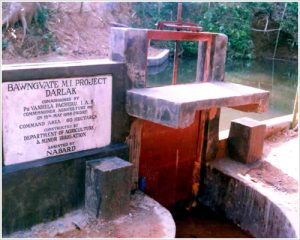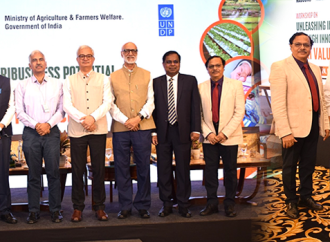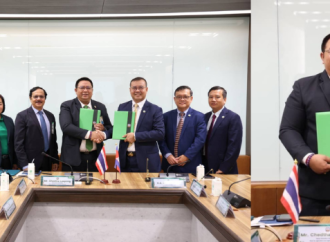By Dr K. G. Karmakar Managing Director NABARD Introduction The National Bank for Agriculture and Rural Development (NABARD) is a unique development financial institution, set up by an Act of Parliament in 1981 for bringing about integrated rural development. Owned jointly by the Reserve Bank of India and the Central Government, it is entrusted with
By
Dr K. G. Karmakar
Managing Director
NABARD
Introduction
The National Bank for Agriculture and Rural Development (NABARD) is a unique development financial institution, set up by an Act of Parliament in 1981 for bringing about integrated rural development. Owned jointly by the Reserve Bank of India and the Central Government, it is entrusted with agricultural credit responsibilities, and developmental activities besides supervisory role over rural financial institutions (RFIs). It seeks to promote sustainable agriculture and equitable rural prosperity through effective credit support, related services, institution development and microfinance innovations. It raises funds from the urban financial markets for deployment in rural India. Over the years, NABARD has established 16 Funds for enabling agricultural and non-agricultural development initiatives and innovations. In tune with national priorities and its own endeavours, NABARD has innovated, piloted and up-scaled credit products and services for rural development, aimed at building the capacities of RFI’s/SHG clientele, building rural value chains, strengthening extension services, etc. for widening and deepening of rural credit absorption capacity in rural areas. The National Bank for Agriculture and Rural Development (NABARD) is a unique development financial institution, set up by an Act of Parliament in 1981 for bringing about integrated rural development. Owned jointly by the Reserve Bank of India and the Central Government, it is entrusted with agricultural credit responsibilities, and developmental activities besides supervisory role over rural financial institutions (RFIs). It seeks to promote sustainable agriculture and equitable rural prosperity through effective credit support, related services, institution development and microfinance innovations. It raises funds from the urban financial markets for deployment in rural India. Over the years, NABARD has established 16 Funds for enabling agricultural and non-agricultural development initiatives and innovations. In tune with national priorities and its own endeavours, NABARD has innovated, piloted and up-scaled credit products and services for rural development, aimed at building the capacities of RFI’s/SHG clientele, building rural value chains, strengthening extension services, etc. for widening and deepening of rural credit absorption capacity in rural areas. The major business loans are given for seasonal agricultural operations, for rural capital investments and for building rural infrastructure. Its major development initiatives are taken up through the Rural Innovation Fund and the Rural Infrastructure Development Fund, the SHG-Bank Linkage Programme, the Watershed Development Fund and the Tribal Development Fund besides the Financial Inclusion and Financial Inclusion Technology Funds and the Microfinance Development and Equity Funds.The major challenges for rural India are as under:
i) Food Security especially in rural and tribal areas
ii) Financial Inclusion by 2015
iii) Poverty alleviation by ensuring Rural Livelihoods
iv) Credit Flow for the Rural Services Sector
v) Strengthening of Cooperatives and Regional Rural Banks
vi) Microfinance Institutions and addressing areas of concern
This paper seeks to analyse the challenges for rural India and find viable answers thereto.

1. Food Security Issues
A major challenge facing NABARD is tackling the problem of hunger and malnutrition affecting one-third of the population. There is also the need to narrow the gap between producer costs and consumer prices so that farmers margins are enhanced through effective marketing support. To tackle global climate change, it is critical to have an institutional mechanism to help farming communities adapt to changing climatic conditions. The food riots in some countries in early 2008 are not forgotten and with oil prices edging to US$100 per barrel, repeats of such food riots are not ruled out. The rising prices of inputs especially seeds, pesticides and fertilizers, diesel costs for pumpsets, spurious inputs, water shortages, controls on food prices, lack of rural infrastructure especially cold storages, godowns, etc. have culminated into lower agriculture production and productivity. To arrest food prices, we need better management of water resources, better quality of seeds, scientific farming practices, rational use of fertilizers, integrated pest management and agricultural diversification. Capital assets creation in agriculture is essential for boosting productivity, such as cost-effective micro irrigation systems. The need to reduce cost of farm credit to 4% (as per National Commission of Farmers, 2004) is another imperative while about 60% of farmers have little or no access to institutional credit, are problems which brook no delay in finding appropriate solutions. The low seed germination rates and the seed replacement rates are also problems eluding solution. In tribal areas, the need for community grain banks is felt and needs to be addressed. The needs of dryland farming are acute in view of 60% of farms depending on monsoon rains. Tribal farmers who are mostly dependent on slash and burn farming techniques need to be weaned away from ecologically destructive farming practices. Availability of agricultural credit in the right amount and in time, is being tested with the formation of Joint Liability Groups and the spread of appropriate or modern technology through Farmers Clubs and KVKs, is also being popularized. The challenge of ensuring good crops for every drop of water, low cost credit, better margins for farmers rather than for traders and better rural infrastructure needs to be met urgently as ours is essentially an agrarian economy. The creation of Farmers Associations for aggregating, sorting, grading, packing and transporting produce, negotiating with traders, taking positions in commodity exchanges, are essential as also weather insurance/crop insurance products that seek to mitigate some of the farmers’ risks. The awesome challenge is to ensure that 85% of the farmers who are small/marginal farmers having un-irrigated land holdings less than 2 hectares, are able to eke out a living for their families.
2. Financial Inclusion
This is not brought about by opening a number of ‘no-frills’ accounts but must include safe bank deposits, affordable credit, safe funds transfers, micro insurance / micro-pensioners and financial literacy/counseling. The formation of self-help Groups (SHGs) and SHG Federations as also microloans by microfinance institutions is also part of financial inclusion. There is a need to implement the Banking Correspondent/Facilitators Model by banks in unbanked areas so as to lower transaction costs for banks and clients as also set up a large number of micro ATMs so that cashless transactions within a common technology platform, is possible in rural areas. The Unique Identification numbers, proposed to be given to all citizens, will also enable quicker financial inclusion. The creation of a Rural Credit Bureau would help in quicker credit decisions than hitherto.
3. Poverty Alleviation
This is not possible without financial inclusion as a means of empowerment and pre-supposes some exposure to financial literacy and banking systems. Without a strong support system, poverty alleviation will remain a dream unless financial margins of farmers and rural artisans are improved. The quality of rural infrastructure especially for rural connectivity (roads, bridges, telecom, etc.) needs major improvement and upgrading. Also cluster development for farm and off farm activities would help in creating employment opportunities for rural growth. The key to poverty alleviation is ensuring livelihoods in and around villages in rural areas. The need for infrastructure and amenities is a must if poverty alleviation is to happen. Today 48% of our people are living below the poverty line and there is a need to address issues such as endemic starvation, hunger, child mortality and women’s health issues. These social issues can be resolved only after urgent poverty alleviation. The need for rural employment (on-farm and non-farm sectors) is acute as is the need for environmental sustainability.
4. The Rural Services Sector
Credit for the rural transportation sector and for rural retail sector are available but for the other segments of the rural services sector such as cheap rural housing, drinking water, sanitation systems, rural eco-tourism and renewable rural energy, the credit flow is virtually non-existent. Unless lending to these sectors is stepped up, the quality of rural life will not improve and the unending migration of rural youngsters to urban areas in search of livelihoods and jobs, will continue. It is said that by 2050 half the population will be in cities! The question that begs an answer is “Will the 50% people remaining in rural areas, be able to produce enough food to feed 100% of the population”? Possibly biotechnology will provide an answer with improved production and productivity. NABARD has a critical role to play in reinvigorating the rural economy.
5. Strengthening Rural Financial Institutions
Cooperatives are the most farmer-friendly institutions in rural areas and most of them are non-viable or are non-functional. The Central and State Governments have pumped in millions of rupees so as to re-capitalize the Regional Rural Banks and the rural cooperative credit institutions, in view of the important roles played by them in rural capital formation and rural credit disbursal. These banks need to develop systems and processes to enable the smooth flow of rural credit and its timely recovery. The RRBs and Cooperatives also need to invest in BC / BF agents and Computer/mobile technologies to enable a wider footprint area for their services without increasing operational costs sharply.
6. Microfinance Issues
The entry of foreign direct investment into microfinance institutions (MFIs) signals a trend of profiteering on poverty. The entry of investors who see easy pickings in MFIs and without any social commitment, are bound to create problems. In the SHG bank linkage programme, high interest rates as per group decisions reflect the risks and profits remain within the SHG. In MFIs the social bonding is lacking as is social collateral! Groups are formed for reducing transaction times and costs only and social motives in forming groups are absent. Also, profits of MFIs are siphoned off for the investors. Prof. Mohd. Yunus, the Grameen Bank founder, terms these MFIs as institutional money lenders! There are other problems such as charging of high interest rates, non-transparency in imposing additional charges for institutional lenders, proliferation of MFIs in over-banked areas (whereas they would be welcome in grossly unbanked areas). Relentless pumping of credit leading to over-lending and multiple membership of SHGs by rural women who often fail to juggle their loans from one SHG to another has led to religious ‘fatwas’ and non-cooperation in villages for loan repayments. There is also no exit policy of NGO’s or MFIs and this results in stagnation if there is no move towards relevant upgraded products such as micro-insurance, health insurance, micro pensions, micro enterprises, etc. Also, there is no regulatory body to oversee the operations of these MFIs and self-regulation does not seem to have any telling impact. All this adds to problems brewing in the microfinance sector. Further, banks seem to have opted for lending funds to MFI’s in bulk as these qualify for priority sector lending norms and are not perturbed by the problems being created by MFI’s which are piling up, leading to an explosive situation later.
7. Perspectives
Institutional mechanisms for smooth flow of agricultural credit are needed along with new processes and IT systems, to enhance outreach and credit availability for farmers on favourable terms. Self-sustaining villages, rain-water harvesting structures to trap water, organic farming practices, SRI practices are all necessary. However, for microcredit, the SHGs seem to be better placed than institutional lenders especially when social collateral norms are concerned. The need for constant upgrading of financial products and technologies adds to the costs of rural credit. The use of BC/BF models for expanding footprint area of banks without creating ‘brick and mortar’ branches is also a step in the right direction. The risk mitigation of agricultural operations for the farmer is a major challenge as also the challenge to provide adequate infrastructure for rural people. The challenges of food security, environmental sustainability financial inclusion and poverty alleviation need to be addressed with urgency and sensitivity, so that tribal people and neglected sections of society are brought into the ambit of development. An inclusional model of rural development based on our credit plus approach has emerged to provide a base for equitable growth and prosperity in the rural areas. If this is not addressed, social strife and unrest under the guise of various revolutionary movements are inevitable, in the underdeveloped and tribal areas of the country.
(i) About NABARD
NABARD is a unique development facilitating and financial institution which also has supervisory responsibilities over 500 rural financial institutions in India. Maintenance of rural credit flows, microfinance innovations, watershed development programmes, the creation of rural infrastructure and bringing about financial inclusion, are some of the major tasks assigned.
(ii) About Dr K.G. Karmakar, MD, NABARD
Dr K.G. Karmakar, 58, has over 35 years experience in commercial banking, central banking and developmental banking. He has been Executive Director (4 years) and Managing Director of NABARD since May 2006. He has written 7 books and published over 80 papers for international/national seminars and reputed journals. He is an authority on rural credit, bank supervision, microcredit and development planning initiatives.















